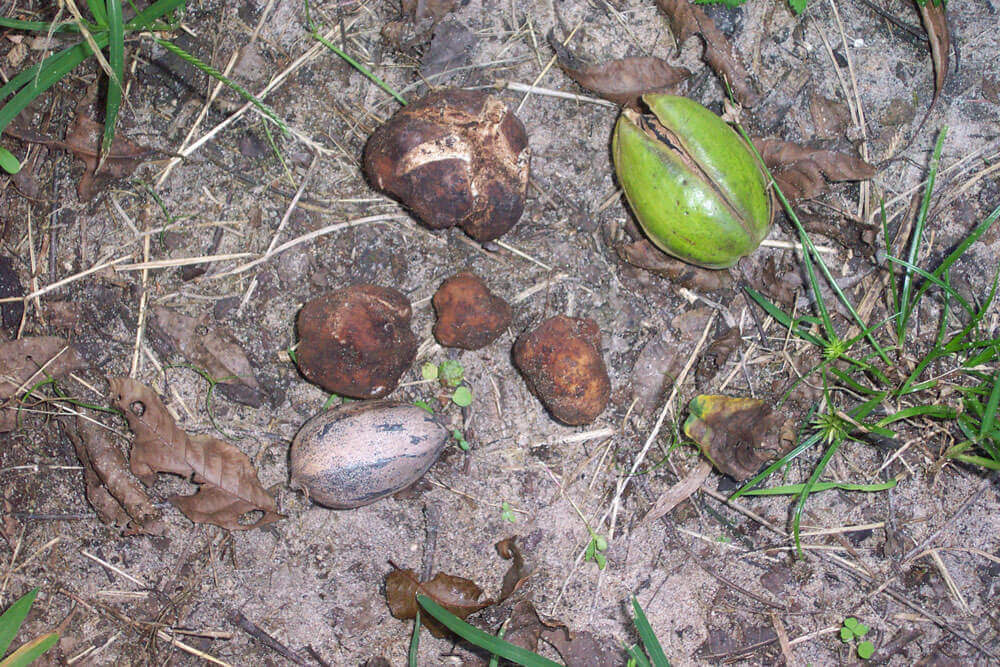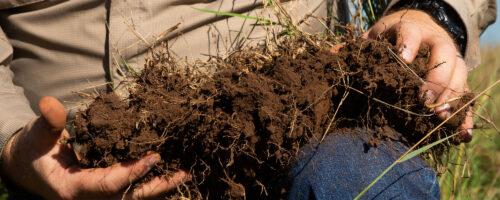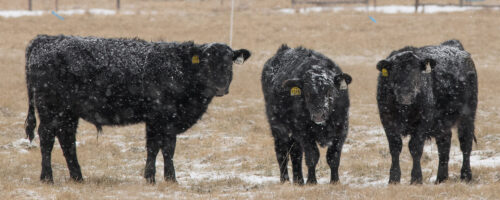With the holiday season approaching, the mere mention of pecan truffles brings thoughts of decadent chocolate caramel candies meant to share with someone special. While that does sound good, it’s not quite what this article is about. The kind of truffle I am talking about is typically searched out by specially trained dogs or pigs rooting around in the soil where tree roots grow. So I guess for this to all make sense, we need to start with: What exactly is a truffle, and what is its relationship with a pecan tree?
To answer these questions, we first must have a lesson in symbiosis and mycorrhizal fungi.
Symbiotic Relationships
Symbiosis is the ecological interaction between two dissimilar organisms intimately living together with one or both receiving benefits. When both members of the association benefit, the symbiotic relationship is called mutualistic.
This concept applies to mycorrhizal fungi, which colonize plant roots. In exchange for carbon from the plant, mycorrhizal fungi facilitate the transfer of soil nutrients (phosphorus, nitrogen, micronutrients and water) from the soil into the plant roots.
Types of Mycorrhizal Fungi
Mycorrhizae are divided into different types. One major group of mycorrhizae is the endomycorrhizae, which grow within the root cells and are typically associated with grasses, row crops, vegetables and shrubs. Another type is called the ectomycorrhizae. They grow on the surface layers of the roots and have a Hartig net of hyphae that physically extends into the root but between the cells. This type is most commonly associated with trees.
Importance of Mycorrhizae
Mycorrhizal infections are important to plants because their associations have been shown to decrease root pathogen attacks and increase the tolerance of the plant to adverse environmental conditions, such as heavy metals, drought and salinity.
In general, mycorrhizas play an important role in sustainable plant productivity and maintenance of soil structure. They can increase plant uptake of phosphorus and trace elements, such as copper and zinc. They do this by extending the volume of soil explored by the plant. These effects on plant growth combine to make the associated plant more robust and to increase its chances of survival.
Truffle History
Truffles could be considered the “caviar” of the fungal world. Even though humans have enjoyed truffles for centuries, their high price has meant few could afford them. The lack of availability, as well as their unique flavor and aroma, have only added to the allure, mystery and fascination of them. Indeed, most of us are content with the chocolate truffles that are readily available without realizing that the term “truffle,” which comes from the Latin word “tūber,” originated from a fungal fruiting body.
Truffles in America
Prized European truffles, such as black, burgandy and white truffles, are the most common ones used in fine cuisine. However, there are a few native species found in North America. One such truffle is called the pecan truffle (scientific name: Tuber lyonii, earlier known as Tuber texense) because it frequently grows in association with the roots of both native and cultivated pecan (Carya illinoinensis) trees.
The ectomycorrhizal nature of truffles is ecologically important for trees but can also be economically important when the truffle is partnered with an important tree crop. In this case, growers can economically benefit from the pecan nuts produced above ground and the truffles produced below the ground.
The native range of pecan truffles stretches across most of eastern North America, from northern Mexico to Quebec and along the Gulf Coast to Florida, to as far west as the Rocky Mountains, according to a 1996 article by J.M. Trappe, et al., published in Mycotaxon, an international scientific journal focused on the taxonomy and nomenclature of fungi.
Pecan truffles have been found in native oak-hickory forests, as well as under pecan or oak trees in home yards and cultivated pecan orchards. Ripe truffles have a strong aroma that attracts mammals that eat them and subsequently spread the spores.
Collecting the Truffles
The process of collecting pecan truffles by hand involves individual collectors using hand rakes, walking up and down pecan tree rows, and raking the surface of the soil to reveal the hidden truffles.
A more successful approach uses the services of a trained truffle-hunting dog. Just as dogs can be trained to track humans or locate drugs, dogs can also be trained to locate the elusive underground truffles. The trick is to keep the animals from eating the truffles once they find them. A trained dog finds truffles more efficiently than raking and generally only harvests mature truffles due to a much stronger aroma than immature truffles.
Using a dog is less destructive to the orchard floor and tree roots than hand raking. Because the soil is not disturbed during truffle hunting with a dog, the same orchard can be visited and harvested several times during a growing season.
In contrast, raking interrupts the production of truffles for that growing season, so harvesting is limited to one event. Also, raking results in mixed collections of mature truffles and immature truffles, according to the Georgia Pecan Magazine article “Pecan Truffles (Tuber lyonii) What We Know and What We Need to Know” in 2012.

Identifying a Truffle
Pecan truffles are produced over the course of many months in the southeastern United States but are strongly dependent on soil moisture. If conditions remain moist, fruiting often continues through the fall until December.
The pecan truffle has several physical characteristics that aid in its identification. For instance, it has a rounded, subterranean fruiting body that can be lobed with shallow to deep furrows, and it has yellowish, tan to dark brown skin. The interior of a pecan truffle is solid, light brown to greyish when young but becomes deeper brown at maturity. The interior is always marbled with narrow, white veins that tend to radiate from the base, and mature specimens have a pungent, rich smell, according to the Mycotaxon article.
Uses for Pecan Truffle
The pecan truffle is desirable because it has a distinct flavor (nutty and earthy) and is currently more affordable than most imported truffle species (i.e., $10-20 per ounce vs. $69-225).
The aromatic compounds produced by mature truffles are destroyed during drying or cooking, so truffles are typically consumed fresh or made into infused oils.
Truffles are also typically cooked at low temperatures with butter, cream or other fatty substances, so that the fat captures and preserves the aromatics.
Additionally, they can be sliced thin and used as a topping on many dishes, such as pasta.
For More Information
Learn more in the University of Florida Extension publication, “The Pecan Truffle (Tuber lyonii): A Gourmet Truffle Native to the Southeastern US.”



Comment